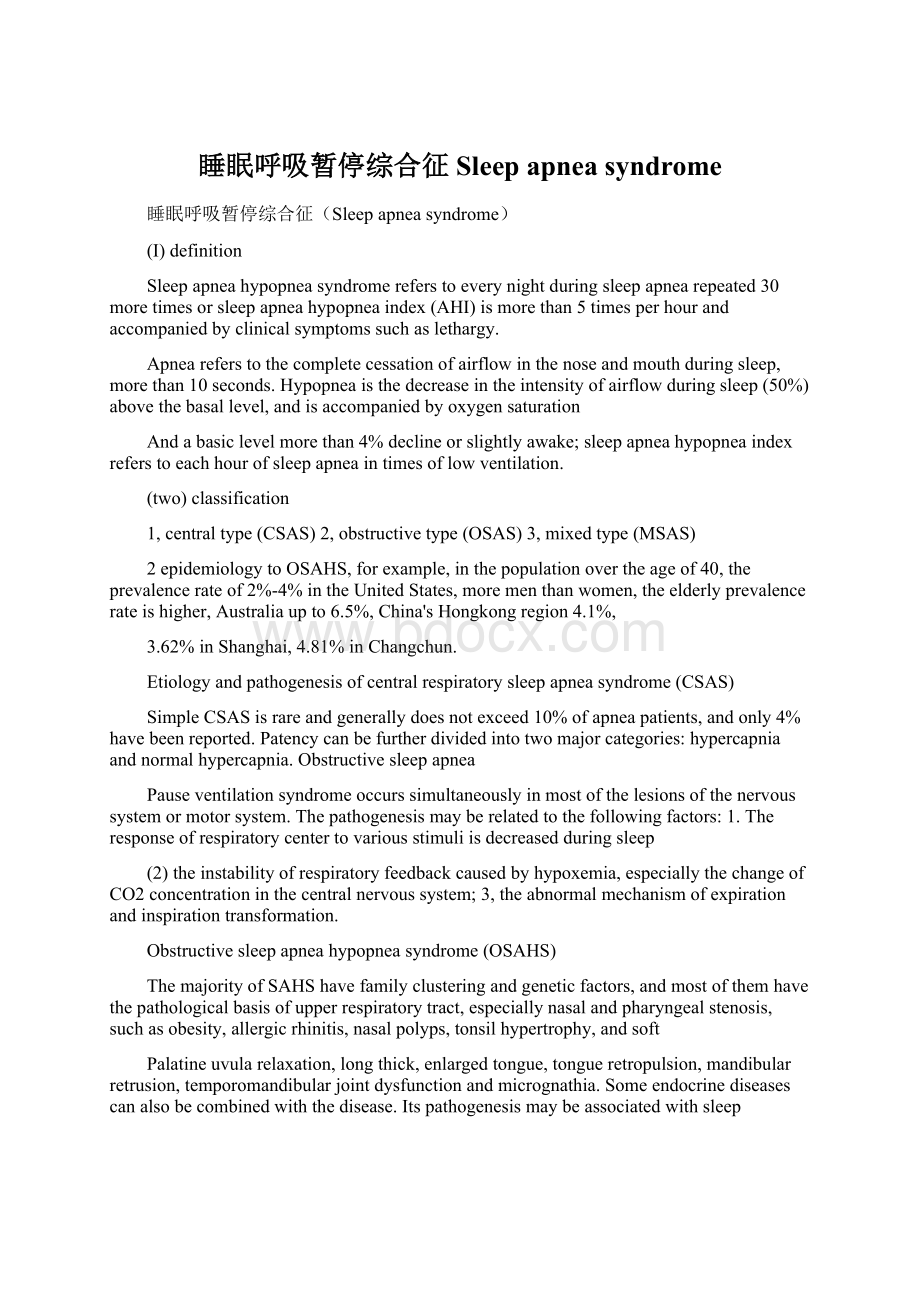 睡眠呼吸暂停综合征Sleep apnea syndrome.docx
睡眠呼吸暂停综合征Sleep apnea syndrome.docx
- 文档编号:6846659
- 上传时间:2023-01-11
- 格式:DOCX
- 页数:5
- 大小:18.50KB
睡眠呼吸暂停综合征Sleep apnea syndrome.docx
《睡眠呼吸暂停综合征Sleep apnea syndrome.docx》由会员分享,可在线阅读,更多相关《睡眠呼吸暂停综合征Sleep apnea syndrome.docx(5页珍藏版)》请在冰豆网上搜索。

睡眠呼吸暂停综合征Sleepapneasyndrome
睡眠呼吸暂停综合征(Sleepapneasyndrome)
(I)definition
Sleepapneahypopneasyndromereferstoeverynightduringsleepapnearepeated30moretimesorsleepapneahypopneaindex(AHI)ismorethan5timesperhourandaccompaniedbyclinicalsymptomssuchaslethargy.
Apneareferstothecompletecessationofairflowinthenoseandmouthduringsleep,morethan10seconds.Hypopneaisthedecreaseintheintensityofairflowduringsleep(50%)abovethebasallevel,andisaccompaniedbyoxygensaturation
Andabasiclevelmorethan4%declineorslightlyawake;sleepapneahypopneaindexreferstoeachhourofsleepapneaintimesoflowventilation.
(two)classification
1,centraltype(CSAS)2,obstructivetype(OSAS)3,mixedtype(MSAS)
2epidemiologytoOSAHS,forexample,inthepopulationovertheageof40,theprevalencerateof2%-4%intheUnitedStates,morementhanwomen,theelderlyprevalencerateishigher,Australiaupto6.5%,China'sHongkongregion4.1%,
3.62%inShanghai,4.81%inChangchun.
Etiologyandpathogenesisofcentralrespiratorysleepapneasyndrome(CSAS)
SimpleCSASisrareandgenerallydoesnotexceed10%ofapneapatients,andonly4%havebeenreported.Patencycanbefurtherdividedintotwomajorcategories:
hypercapniaandnormalhypercapnia.Obstructivesleepapnea
Pauseventilationsyndromeoccurssimultaneouslyinmostofthelesionsofthenervoussystemormotorsystem.Thepathogenesismayberelatedtothefollowingfactors:
1.Theresponseofrespiratorycentertovariousstimuliisdecreasedduringsleep
(2)theinstabilityofrespiratoryfeedbackcausedbyhypoxemia,especiallythechangeofCO2concentrationinthecentralnervoussystem;3,theabnormalmechanismofexpirationandinspirationtransformation.
Obstructivesleepapneahypopneasyndrome(OSAHS)
ThemajorityofSAHShavefamilyclusteringandgeneticfactors,andmostofthemhavethepathologicalbasisofupperrespiratorytract,especiallynasalandpharyngealstenosis,suchasobesity,allergicrhinitis,nasalpolyps,tonsilhypertrophy,andsoft
Palatineuvularelaxation,longthick,enlargedtongue,tongueretropulsion,mandibularretrusion,temporomandibularjointdysfunctionandmicrognathia.Someendocrinediseasescanalsobecombinedwiththedisease.Itspathogenesismaybeassociatedwithsleep
Inthesleepstate,thecollapseoftheupperairwaysofttissueandmuscleincreased,andtheupperairwaymuscleduringsleepwasrelatedtothedecreaseofhypoxiaandcarbondioxidestimulation.Inaddition,itwasalsorelatedtonerves,bodyfluids,endocrineandsoon
Thecombinedeffectsofbiotin.
Clinicalmanifestations(I)clinicalmanifestationsduringtheday
1lethargy:
themostcommonsymptomsarelightdaytimeworkorstudytime,drowsinessandlethargy,eatingwhenyouareserious,talkingtopeopleandfallingasleep,andevenseriousconsequences,suchasplayingwhiledriving
Sleepinessleadstotrafficaccidents.
2,dizziness,fatigue:
duetorepeatedapneaatnight,hypoxemia,continuoussleepinterruption,increasednumberofwaking,sleepqualitydecreased,oftenslightlydifferentdizziness,fatigue,fatigue.
3,mentalandbehavioralabnormalities:
inattention,fineoperationabilitydecline,memoryandjudgmentdecline,symptomscannotworkwhensevere,elderlypeoplecanshowdementia.Nocturnalhypoxemia
Braindamageandchangesinsleepstructure,especiallyduringperiodsofdeepsleep,arethemaincauses.
4,headache:
ofteninthemorningoratnight,arare,severe,sustainable1-2hours,sometimesneedtotakepainkillerstoease,andthechangeofbloodpressure,intracranialpressureandcerebralbloodflowrelated.
5,personalitychanges:
irritability,irritability,anxiety,familyandsociallifeareaffected,duetofamilymembersandfriendsemotionalalienation,depressionmayoccur.
6,sexualdysfunction:
about10%ofpatientsmayhavesexualdesiredecline,orevenimpotence.
(two)clinicalmanifestationsatnight
1,snoring:
isthemainsymptom,snoringirregular,rangingfromheight,oftensnoring,airflow-stopwheezing-Snoringalternately,thegeneralairinterruptiontimeof20-30seconds,individualupto2minutesormore,
Thiscanoccurinpatientswithobviouscyanosis.
2,apnea:
75%oftheroomorbedwithsleepapneawerefound,oftenworryaboutbreathingisnotrestoredandpushuppatientswithapnea,breathingarousalorloudsnoringandtermination.
PatientswithOSAHShadpronouncedchestandabdominalparadoxicalbreathing.
3,suppresswaking:
apneasuddenlywakeup,oftenaccompaniedbyturningover,limbsinvoluntarymovement,orevenconvulsions,orsuddenlystart,feelflustered,chesttightnessorprecordialdiscomfort.
4,hyperactivity:
duetohypoxemia,patientsturnaroundatnightandturnmorefrequently.
5,sweat:
sweatmore,totheneck,chest,andairwayobstructionafterrespiratoryeffortandapneacausedbyhypercapnia.
6,nocturia:
somepatientscomplainedofnocturnalenuresisincreasedfrequencyofurination,theemergenceofindividual.
7,sleepbehaviordisorder:
forfear,screaming,raving,noctivagant,phonism.
(three)themanifestationsofsystemicorgandamage
OSAHSisoftenthefirstsymptomandsignofabnormalcardiovascularsystem.Itcanbeanindependentriskfactorforhypertensionandcoronaryheartdisease.1.Hypertension:
theincidenceofhypertensioninOSAHSpatientsis45%,
Antihypertensivedrugswerenoteffective.
2coronaryheartdisease:
manifestedasvarioustypesofarrhythmia,nocturnalanginaandmyocardialinfarction.Twentybecauseofhypoxiainducedcoronaryarteryendothelialdamage,lipiddepositionintheintima,andredbloodcells
Increasedbloodviscosity.
3,varioustypesofarrhythmia.
4,pulmonaryheartdiseaseandrespiratoryfailure.
5,ischemicorhemorrhagiccerebrovasculardisease.
6,mentaldisorders:
suchasmanicpsychosisordepression.
7diabetes.
5laboratoryandotherexaminations
(1)bloodtest:
longdurationofillness,hypoxemia,severe,redbloodcellcountandhemoglobinmayhavevaryingdegreesofincrease.
(two)arterialbloodgasanalysis:
severeorcomplicatedwithpulmonaryheartdiseaseandrespiratoryfailuremayleadtohypoxemia,hypercapniaandrespiratoryacidosis.
(three)chestX-rayexamination:
whenaccompaniedbypulmonaryhypertension,hypertensionandcoronaryheartdisease,itcanincreasetheimageoftheheart,andhighlightthecorrespondingsymptomsofpulmonaryarterysegment.
(four)pulmonaryfunctiontest:
whentheconditionisserious,pulmonaryheartdiseaseandrespiratoryfailure,therearedifferentdegreesofventilationdysfunction.
(five)electrocardiogram:
whenhypertensive,coronaryheartdisease,appearventricularhypertrophy,myocardialischemiaorarrhythmiachange.
Diagnosis
Accordingtotypicalclinicalsymptomsandsigns,itisnotdifficulttodiagnoseSAHS.Thediagnosisandunderstandingoftheseverityandtypeofthediseaseneedtobecheckedaccordingly.
(1)clinicaldiagnosis:
accordingtosleepsnoring,apnea,daytimesleepiness,bodyfat,neckcircumferenceandotherclinicalsymptoms,clinicaldiagnosiscanbemade.
(two)polysomnography:
PSGmonitoringisthegoldstandardforthediagnosisofSAHS,anditcandeterminethetypeandseverityofthedisease.
(three)etiologicaldiagnosis:
routinediagnosisofSAHS,nose,larynxandmouth,andlocalanatomyanddysplasia,hyperplasiaandtumorwereobserved.Radiographsoftheheadandneck,CTandMRImeasurements
Thetransversesectionalareaofthepharynxcanbeusedasanarrowlocation.Theendocrinesystemcanbemeasuredinsomepatients.
differentialdiagnosis
(a)simplesnoring:
thereisobvioussnoring,PSGexaminationdoesnotmeetthediagnosisofupperairwayobstructionsyndrome,noapneaandhypoventilation,nohypoxemia.
(two)upperairwayresistancesyndrome:
increasedairwayresistance.
(three)narcolepsy:
excessivedaytimesleepiness,cataplexyattack.Haveafamilyhistory.
Treatment
(I)treatmentofcentralsleepapneasyndrome:
1,thetreatmentofprimarydiseases:
suchasnervoussystemdiseases,congestiveheartfailuretreatment.
2,respiratorystimulantdrugs:
mainlytoincreasetherespiratorycenterofthedrivingforce,improveapneaandhypoxemia.Use:
Amiethreetriazine(50mg,2-3/day),acetazolamide(125-250mg,3-4/min
Ortake250mgbeforegoingtobed)andtheophylline(100-200mg,2-3times/day).
3,oxygentherapy:
cancorrecthypoxemia,forsecondarytocongestiveheartfailurepatients,canreducethenumberofapneaandhypoventilation,neuromusculardiseasemayexacerbatehypercapnia,butifcombined
AndOSAHSmayexacerbateobstructiveapnea.
4、auxiliaryventilationtreatment:
forseverepatients,mechanicalventilationcanenhancespontaneousbreathing,noninvasivepositivepressureventilationandinvasivemechanicalventilationcanbeused.
(two)treatmentofobstructivesleepapneahypopneasyndrome
1,generaltreatment:
(1)weightloss:
dietcontrol,drugsandsurgery.
(2)sleeppositionchange:
lateralsleep,raisingthebedside.(3)quitsmokingwineandavoidtakingsedatives.
2,drugtreatment:
theeffectisnotcertain.Tryacetazolamide.Modafiniltoimprovedaytimesleepiness,usedtoimprovethesymptomsofsleepinessafterCPAPtherapyinpatientswithobvious,haveacertaineffect.
3.Medicaltreatment:
(1)nasalcontinuouspositiveairwaypressure(nasal-continuous,positive,airway,pressure,CPAP);
Indications:
AHImorethan15timesperhourinpatients.AHI<15times/hour,butthedaytimesleepinessandotherobvioussymptoms.Surgicaltreatmentfailureorrecurrenceofpatients.Unabletotolerateothertreatmentmethods.
Contraindications:
coma,bullae,hemoptysis,pneumothorax,an
- 配套讲稿:
如PPT文件的首页显示word图标,表示该PPT已包含配套word讲稿。双击word图标可打开word文档。
- 特殊限制:
部分文档作品中含有的国旗、国徽等图片,仅作为作品整体效果示例展示,禁止商用。设计者仅对作品中独创性部分享有著作权。
- 关 键 词:
- 睡眠呼吸暂停综合征Sleep apnea syndrome 睡眠 呼吸 暂停 综合征 Sleep
 冰豆网所有资源均是用户自行上传分享,仅供网友学习交流,未经上传用户书面授权,请勿作他用。
冰豆网所有资源均是用户自行上传分享,仅供网友学习交流,未经上传用户书面授权,请勿作他用。


 铝散热器项目年度预算报告.docx
铝散热器项目年度预算报告.docx
